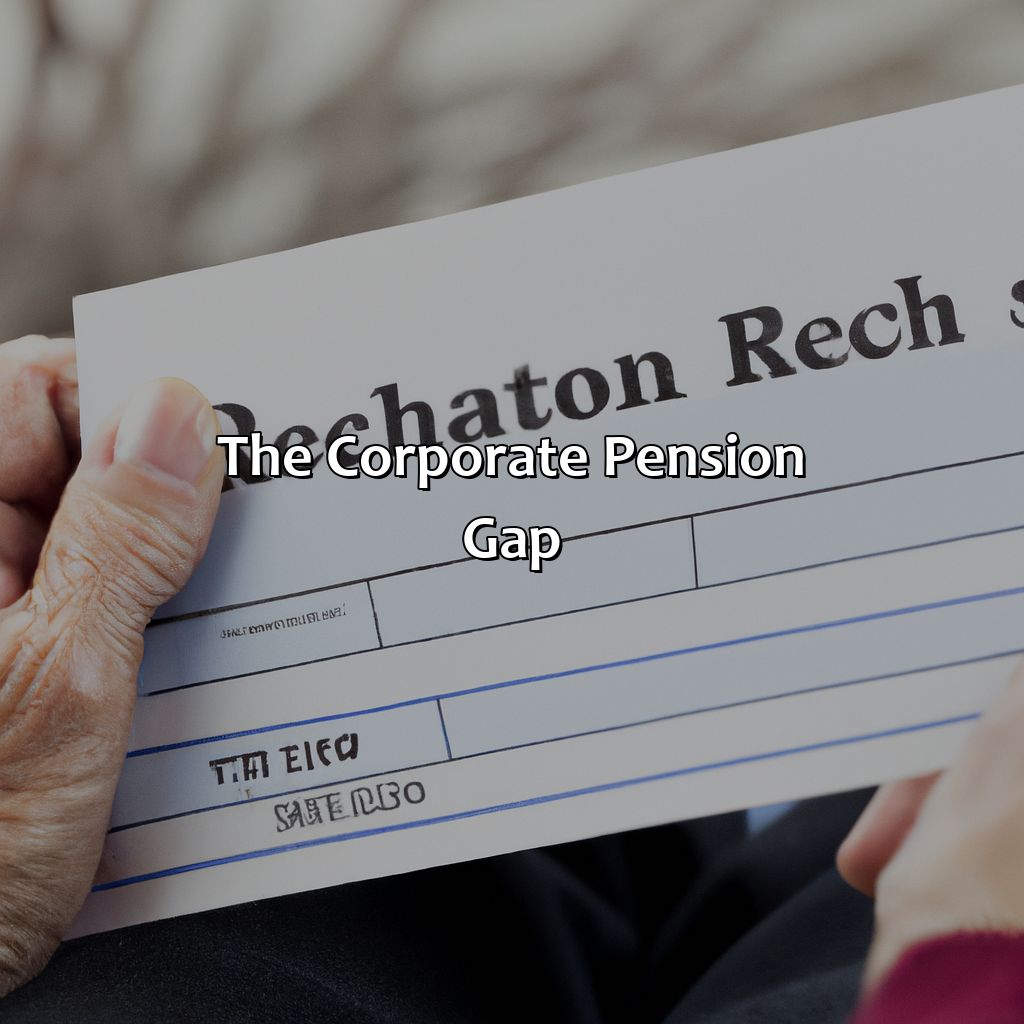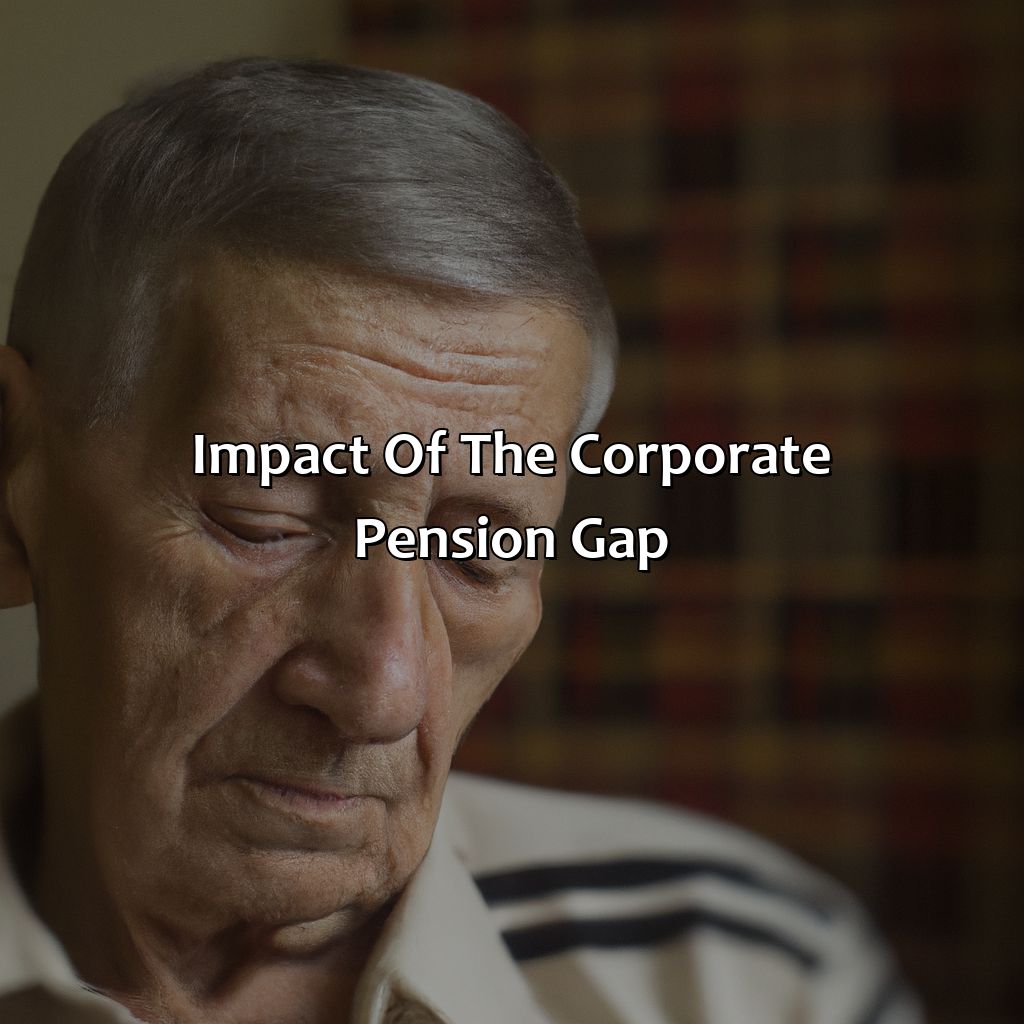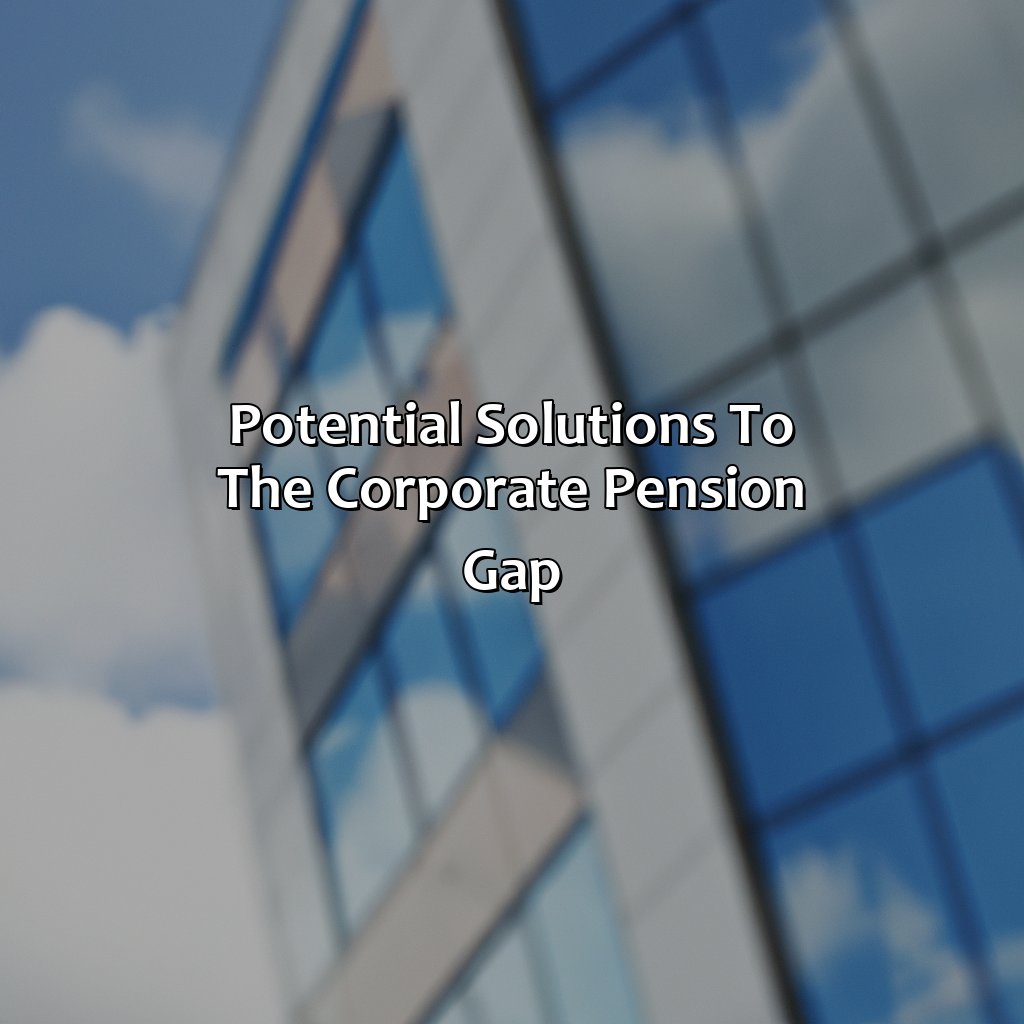Why The Corporate Pension Gap Is Soaring?
Key Takeaway:
- The corporate pension gap is soaring due to several factors, including longer life expectancies, low interest rates, and economic downturns that have impacted investment portfolios.
- Retirees are facing significant financial challenges as a result of the pension gap, including reduced benefits and increased costs, which can impact their quality of life in retirement.
- To address the growing pension gap, potential solutions include implementing retirement savings plans, such as 401(k)s, and enacting pension reforms that promote more sustainable funding models for corporate pension systems.
Are you concerned about the widening gap between corporate pensions and the cost of living in retirement? This article will explain why the corporate pension gap is widening and how to protect yourself from future financial turmoil. You will also get an insight into how to plan your retirement better.
The Corporate Pension Gap
We’ll help you understand the corporate pension system and why the pension gap between employers and employees is growing bigger. To tackle the pension gap, let’s explore the system and its causes. This section is called “The Corporate Pension Gap“.

Image credits: retiregenz.com by Harry Arnold
Understanding the Corporate Pension System
Corporate Pension System – An Overview
The corporate pension system is a complex financial structure that provides post-retirement benefits to employees. It is imperative for employers to keep their pension plans adequately funded, but the funding levels have been steadily decreasing over the years.
The Impact of Lower Funding Levels
The decrease in funding levels has led to a significant increase in the corporate pension gap, leaving many employees without proper retirement benefits. The factors behind this shortfall include low bond yields, longevity risk, and regulatory changes.
The Need for Proper Planning
Employers need to take stock of their pension plan status and engage in proper planning to ensure they can meet their obligations. It requires a thorough understanding of the costs associated with providing these benefits, as well as a clear understanding of employee needs.
A Real-World Story
In 2012, American Airlines filed for bankruptcy protection, which included canceling its employee pension plans. This left more than 130,000 active and retired workers unsure about their retirement benefits. Although the company emerged from bankruptcy later that year and reinstated its pensions under new plans, many employees still faced significant cuts in their retirement checks.
“Apparently, the only retirement plan some corporations have is to hope their employees die before they have to pay out their pension.”
Reasons Behind the Gap
The increasing discrepancy in corporate pensions is a result of several factors. The shift from defined benefit plans to defined contribution plans reduced employer liability. Uncertainty and volatility in the securities market also contributed to the widening gap. Moreover, longer life expectancies increased the cost of pension obligations.
The decrease in funding levels, especially after the 2008 crisis, has worsened the situation further. Poor investment returns led to underfunded plans, reducing the ability to meet future obligations and forcing companies to contribute more toward these plans.
Lastly, regulatory changes to accounting standards for pensions forced companies to disclose more information about their pension liabilities and expenses. This revelation improved transparency but highlighted discrepancies between company performance and expectations.
To address this gap, companies can implement better risk management strategies that mitigate exposure to market conditions. Focusing on innovative solutions such as annuities, defined-ambition plans and collective multi-employer agreements may provide employees with greater security while maintaining manageable risk levels for employers. Companies must be proactive in managing their obligations instead of reacting when they become problematic which will lead to long term success and sustainability for all stakeholders involved.
The only impact the corporate pension gap has is on retirees who have to sell their kidneys to afford a decent retirement.
Impact of the Corporate Pension Gap
Uncover the corporate pension gap’s effects on retirement. Dive into the consequences it has on retirees and companies. Grasping these results can help comprehend what awaits those relying on corporate pensions. Analyzing the gap’s impacts can help us all better understand.

Image credits: retiregenz.com by Harry Jones
Effects on Retirees
The widening corporate pension gap is having significant ramifications for retired individuals. Pensions play a crucial role in ensuring retirees’ financial security. However, with the substantial deficit between the pension funds and liabilities, many retirees are left vulnerable to experiencing a decline in the standard of living they anticipated post-retirement.
A lack of funds means that some retirees may be unable to afford basic necessities such as healthcare and housing. Additionally, those reliant on company pensions face uncertainty over whether they will receive their regular payments or not. This instability can lead to increased stress and anxiety levels among seniors.
Retirees who were entirely dependent on their employer’s pension plan are at risk of falling below the poverty line due to a considerable shortfall in funds. These people have little choice but to seek government support and live frugally to get by. Those who saved insufficiently or invested poorly during their working years may be especially vulnerable.
One retiree who depends on a corporate pension shared her story about how the ongoing pandemic has added further strain. She spoke about how she had planned her retirement around her monthly payouts from her former employer, which she now fears may not be forthcoming due to the widening pension gap. Her key takeaway was about how essential it is for retirees to have alternate income streams or savings plans as backup if their primary source of income falters unexpectedly. Why is my pension going down 2022 is a question on every retiree’s mind and this story explains why.
Looks like corporations are ditching their pension plans faster than a cheating spouse runs from a private investigator.
Effects on Corporations
The widening gap in corporate pensions is causing detrimental effects on businesses worldwide. Not only are they facing increased financial burdens, but also worker dissatisfaction and lowered employee retention. In order to retain quality employees, corporations should consider reevaluating their pension plans and working with financial advisors to find sustainable solutions.
One of the major consequences of this pension gap is the cost associated with funding these plans. As it continues to grow, corporations may be forced to cut spending in other areas or increase costs for consumers, leading to a less competitive market. Furthermore, employees may feel undervalued and undercompensated if their retirement benefits fall short.
To combat these issues, corporations must prioritize pension planning as part of their overall business strategy and allocate necessary resources accordingly. Seeking expert advice can help mitigate financial risks and ensure long-term stability for both the corporation and its employees.
Don’t let your corporation fall behind on pension planning – take action now to prevent further losses and retain quality staff. With so much at stake, it’s important to act fast before it’s too late.
Will companies finally step up and fill the pension gap or will employees have to resort to eating ramen noodles in retirement?
Potential Solutions to the Corporate Pension Gap
To tackle the corporate pension gap, as “Why the Corporate Pension Gap is Soaring?” suggests, you can think about introducing retirement savings plans. These plans give employees a chance to get ready for their future. Additionally, pension reform can work to tackle the systemic issues causing the pension gap.

Image credits: retiregenz.com by David Jones
Retirement Savings Plans
Retirement Investment Alternatives:
Retirement investment opportunities allow individuals to plan for their future and save money for their retirement years.
- Pension Scheme: A retirement savings plan sponsored by an employer, which usually requires continuous contributions from both the employee and the employer to safeguard a retiree’s financial needs before and during retirement.
- 401(k) Plan: A contribution scheme in which an employee can decide how much money they want to contribute monthly or yearly from their salary towards a pension account without bearing any tax liabilities until he or she withdraws at retirement.
- IRA: An Individual Retirement Account is exclusively financed by individuals on a pre-tax basis. This means that no taxes are charged on your savings until you start withdrawing them at the age of 59 1/2.
- Roth IRA: It is another alternative investment plan, where people invest after-tax funds instead of pre-tax contributions. Withdrawals made from this account do not bear any additional costs or taxes; thus, they are mostly tax-free upon redemption.
Investment plans help in saving and safeguarding finances beyond general savings accounts, as they present numerous benefits such as automated contributions that may help increase employees’ contribution levels. They can also provide diversified portfolio alternatives that otherwise might not have been possible with other savings methods.
Get started with saving today to ensure a smooth post-retirement life.
Getting old is inevitable, but depending on a corporate pension to support you in your golden years? That’s just risky business.
Pension Reform
The increasing challenge of providing corporate pensions has led to a pressing demand for Pension Restructuring. Corporate leaders are scrambling to discover strategies that will aid in the closing of the pension gap, which is increasing at an alarming rate.
To confront the Corporate Pension Gap, many companies have focused on implementing long-term measures that concentrate more on creating effective retirement plans than short-term ones. Consequently, this aligns business results with the objectives of employee development.
A wide range of options for pension reform is available to businesses seeking alternatives. An alternative option is a combination of bundled strategies and customized approaches that present prospective participants with tailored options while also offering cost-saving efficiencies.
Pension reform presents distinct opportunities within companies that employees may want to take advantage of. Developing customizable plans and systems can help close the pension gap and navigate through today’s changing economic environment. Companies that do not update their procedures risk being left behind, becoming less competitive and having difficulty attracting top talent.
Therefore, it is imperative for corporate institutions to implement timely solutions to tackle pension crises accurately. Failure to create innovative programs now will lead millions of people facing severe consequences in later life.
Five Facts About Why the Corporate Pension Gap is Soaring:
- ✅ The corporate pension gap in the US reached $1.4 trillion in 2019. (Source: Wall Street Journal)
- ✅ Only 16% of Fortune 500 companies still offer traditional pension plans to new hires. (Source: Willis Towers Watson)
- ✅ The shift from traditional pensions to 401(k) plans has left employees bearing the risk of market fluctuations and longevity. (Source: Business Insider)
- ✅ Low interest rates and longer lifespans have put pressure on corporate pension plans to meet their obligations. (Source: CNBC)
- ✅ The COVID-19 pandemic has caused further strain on corporate pension plans, with many companies suspending or reducing contributions. (Source: Bloomberg)
FAQs about Why The Corporate Pension Gap Is Soaring?
Why is the corporate pension gap soaring?
The corporate pension gap is soaring due to several factors. One of the biggest contributors is the aging workforce, which means employees are living longer and drawing a pension for a longer period of time. Additionally, lower interest rates have reduced investment returns, which has made it more difficult for pension funds to meet their obligations.
What is the corporate pension gap?
The corporate pension gap refers to the difference between the assets that corporations have set aside to pay pensions and the pension obligations they have made to their employees. If the assets fall short of the obligation, the corporation must come up with additional funds to pay the pensions.
How big is the corporate pension gap?
The corporate pension gap is estimated to be in the trillions of dollars. According to the Pension Benefit Guaranty Corporation (PBGC), the agency that insures corporate pensions, the deficit for single-employer pension plans was $63.7 billion in 2020, up from $8.7 billion in 2019.
What are the consequences of the corporate pension gap?
The consequences of the corporate pension gap can be severe. When companies are unable to meet their pension obligations, current and retired employees may face reduced pension payments or even lose their pension altogether. Additionally, a large pension gap can hurt a company’s financial stability and credit rating.
What can be done to address the corporate pension gap?
There are several steps that can be taken to address the corporate pension gap. These include increasing contributions to pension plans, reducing pension obligations, and investing in higher-return assets. Additionally, policymakers can provide incentives to encourage companies to fully fund their pension plans.
Is the corporate pension gap a problem for all companies?
The corporate pension gap is not a problem for all companies, but it is a bigger issue for some than others. Companies with defined benefit pension plans are more likely to have a pension gap, as they are responsible for paying a set amount to employees regardless of market fluctuations. Companies with defined contribution plans, such as 401(k)s, do not have the same pension-related obligations.


